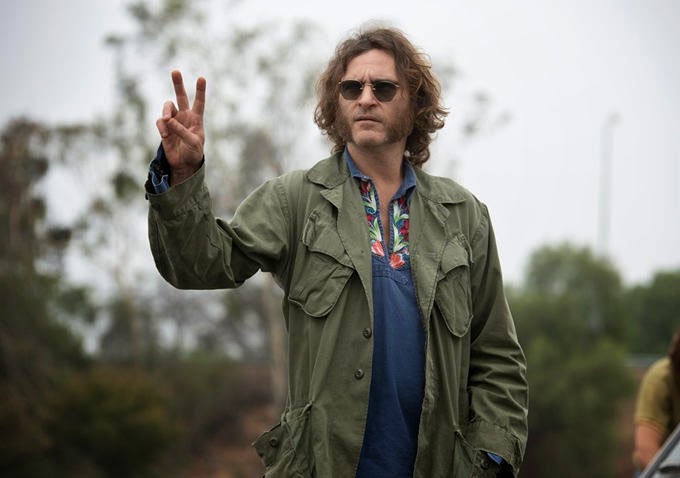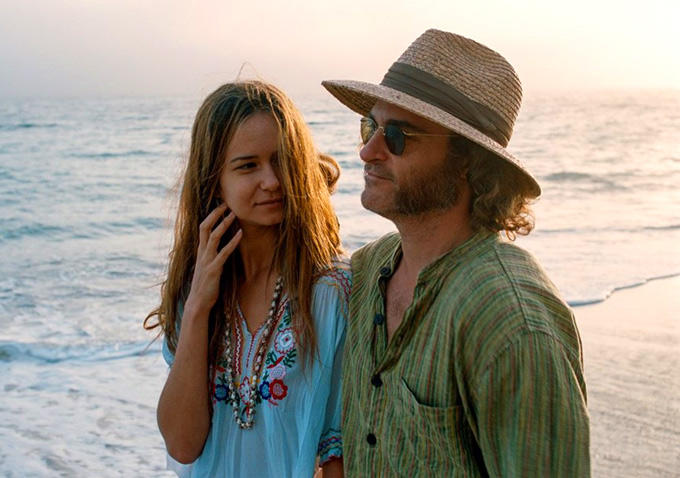NOT A REVIEW: Inherent Vice

“I never remember plots in movies. I remember how they make me feel and I remember emotions and I remember visual things that I’ve seen, but my brain can never connect the dots of how things go together.”—Paul Thomas Anderson
Neil Young pulls up to a bridge somewhere in sun-soaked California. He parks the wheezing jalopy and steps outside in a hefty fur coat armed with a jug full of apple juice, a box of strawberries, and a joint. He and his girlfriend rest themselves on the bumper and pass the trifles of earthly delight back and forth. The camera peering over the bushes slowly zooms in on Young, who stares back into the heart of the lens with a glazed tint in his eyes. The moment lingers long after it logically should end. Finally, Neil Young gets back into the car with his girl. The engine stalls. Smoke seeps from the bottom of the scrap heap. A few more tries before the clunker gags and it’s back on the road.
The scene is from Journey Through The Past, Neil Young’s first foray into filmmaking, which was released in 1974. I first saw this strangely arresting moment during Paul Thomas Anderson’s “On Cinema” masterclass at the New York Film Festival just one day after the world premiere of his new film, Inherent Vice. I’ve read the myriad comparisons to other “stoner detective movies” like The Big Lebowski and The Long Goodbye – the Robert Altman film laid the groundwork for Vice and Lebowski decades earlier – but it’s this scene from the Young film that seems to yield the most apt comparison of all.
Adapted from the Thomas Pynchon novel, Inherent Vice takes place in the year 1970. Hippies still walk the Earth but flower power is dead. It is in this post-Manson, post-Altamont, present-Nixon America that Doc Sportello (Joaquin Phoenix) finds himself entangled in a deeply complicated case involving ex-girlfriend Shasta Fay Hepworth (Katherine Waterson), lantern-jawed detective Bigfoot Bjornsen (Josh Brolin), marine law specialist Sauncho Smilax (Benicio Del Toro), missing real estate mogul Mickey Wolfmann (Eric Roberts), missing heroin-addicted saxophonist Coy Harlingen (Owen Wilson), cocaine-snorting dentist Rudy Blatnoyd (Martin Short), a Neo-Nazi biker gang, nose-picking FBI agents, and a mysterious organization called the Golden Fang, casting a sinister shadow over the proceedings.

Anderson’s approach to adapting the book was to transcribe every word of the text so he could mold it into the best Pynchon adaptation he could possibly make. In doing so, he wisely took the minor character Sortilège (Joanna Newsom) and elevated her to the film’s narrator and confidant. This keeps much of the heightened and paranoid Pynchonian text in tact, providing viewers with a clear enough entry point into the author’s ramshackle world while adding an extra ethereal element. Is Sortilège a product of one too many chemicals smoked or is she an earthbound guardian angel—or is she simply one of Doc’s hippy friends?
The pleasures of Inherent Vice have less to do with following the plot and uncovering the mysteries therein than taking the slow ride down the weed-fogged streets of Anderson and Pynchon’s vision. This is not a film that can easily be placed into star-categories or given a letter-grade. Parts of it play like a punchy and surreal Three Stooges stoner comedy, and I laughed all the way through Inherent Vice, while other parts play like an early Leonard Cohen ode to lost love—sometimes overlong but poignant all the same.
Whereas Anderson’s camera used to jolt its way from one character to the next using jarring whip pans and feverish tracking shots, it is now content to sit back, relax, and enjoy the show. Robert Elswit’s cinematography basks in a hazy tint akin to a faded Polaroid or an old vinyl sleeve showing signs of wear and tear. Depending on what the camera is looking at, this effect is either calming or unnerving. This is where, to quote Matt Zoller Seitz, “the film feels stoned.” When the high is mellow, you never want it to end. But once it becomes harsh and unkind, you want to claw your way toward sobriety.

Like all of Anderson’s work, it demands to be seen at least twice. I have only seen the film once, and while it didn’t knock me out like There Will Be Blood or Boogie Nights, it is a film I find myself thinking about often. His last film, The Master, had a similar but more bewildering effect on me. I brought too many expectations to my first screening of that film, but as time as passed, the rewards are richer and more plentiful than I expected. Anderson has never been a director of plots; he is a director of characters. He allows his creations to take the story in whatever direction they’d like. That is what makes his filmmaking so human and so meaningful to me. Every film he makes is an epic regardless of whether or not the plots themselves qualify as epic. But he has enough genuine affection for his characters that he grants them the epic scopes they deserve.
“I remember how they make me feel,” said Paul Thomas Anderson at that New York Film Festival masterclass. After coming home from Inherent Vice with my lady, I knew exactly how I felt: I wanted to spend the cool December evening with her and her alone while we got high and listened to Neil Young. As Elliott Gould frequently says in The Long Goodbye, “That’s okay with me.”

GET CHOMPED